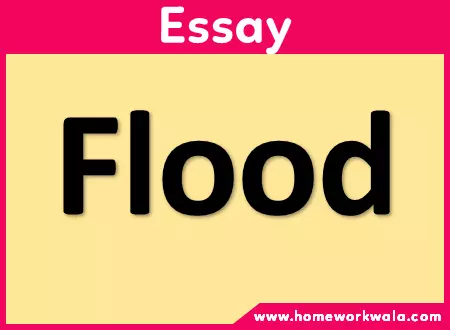Table of Content
Today, In this article we are going to write essay on Flood in English in 400 words.. This article is about Flood.
This post can help the school students who are looking “Flood par nibandh English mein”. We briefing about “Flood in the English” which is very useful for student.
This essay on “Flood” is generally useful for class 7, class 8, class 9 and 10.

Simple essay on Flood in English
Introduction
One of the frequently occurring natural disasters on our planet is floods. It can cause widespread destruction, loss of life, and economic consequences. Landslides are classified as a type of natural disaster. In this essay, we will explore the causes, effects, and history of floods, as well as flood preparedness and response.
Causes of floods
Floods can be caused by a variety of factors, including heavy rainfall, snowmelt, dam or levee failures, and coastal storms. Human activities, such as deforestation and urbanization, can also increase the risk of flooding.
Effects of floods
The effects of floods can be devastating. They can cause damage to buildings and infrastructure, leading to loss of life and economic consequences. Floods can also contaminate water supplies, disrupt transportation systems, and trigger landslides.
History of floods
Floods have been happening for as long as the Earth has existed, and they have played a significant role in shaping our planet’s landscape. Some notable floods in history include the Great Flood in the Bible, the 1931 China floods, and the 2005 Hurricane Katrina floods.
Flood preparedness
It’s important to be prepared for floods, as they can strike without warning. Some measure individuals and communities can take include monitoring weather forecasts, building flood-resistant structures, and having an emergency plan in place.
Response to floods
Governments and aid organizations play a crucial role in responding to floods. Disaster relief efforts can include search and rescue operations, providing emergency shelter and supplies, and rebuilding damaged infrastructure.
Conclusion
Floods are a powerful reminder of the raw power of nature. While we can’t prevent floods from occurring, we can take steps to be prepared and respond effectively when they do happen. By working together, we can minimize the devastating effects of floods and rebuild stronger and more resilient communities.
You May Also Like
FAQ about Flood
- What causes floods?
- How do floods affect people?
- Can floods be predicted?
- How can I prepare for a flood?
- How do governments and aid organizations respond to floods?
- What can be done to reduce the risk of flood damage?
Floods can be caused by a variety of factors, including heavy rainfall, snowmelt, dam or levee failures, and coastal storms. Human activities, such as deforestation and urbanization, can also increase the risk of flooding.
Floods can have a wide range of effects on people, including loss of life, injuries, and psychological trauma. They can also cause damage to buildings and infrastructure, leading to economic consequences. Floods can contaminate water supplies and disrupt transportation systems, making it difficult for people to access essential goods and services.
While scientists have made progress in understanding the causes and patterns of floods, they still cannot predict them with absolute certainty. However, they can estimate the likelihood of flooding occurring in a given area and provide early warning systems to help people prepare.
There are several measures individuals and communities can take to prepare for floods, including monitoring weather forecasts, building flood-resistant structures, and having an emergency plan in place. It’s also important to have a supply of clean water, non-perishable food, and other emergency supplies on hand.
Governments and aid organizations play a crucial role in responding to floods. Disaster relief efforts can include search and rescue operations, providing emergency shelter and supplies, and rebuilding damaged infrastructure.
Building codes and regulations can help reduce the risk of flood damage by requiring structures to be designed and constructed to withstand flooding. Researchers are also working on developing new materials and technologies to improve flood resistance. Additionally, natural flood control measures such as wetland restoration and reforestation can help mitigate the impact of floods.
We hope you like this post about essay on Flood in English. We are very glad to help the students to do their homework in an effective way. This was a “Flood ka essay English mein”. This type of questions generally asked the students in their schools to write essay on Flood.